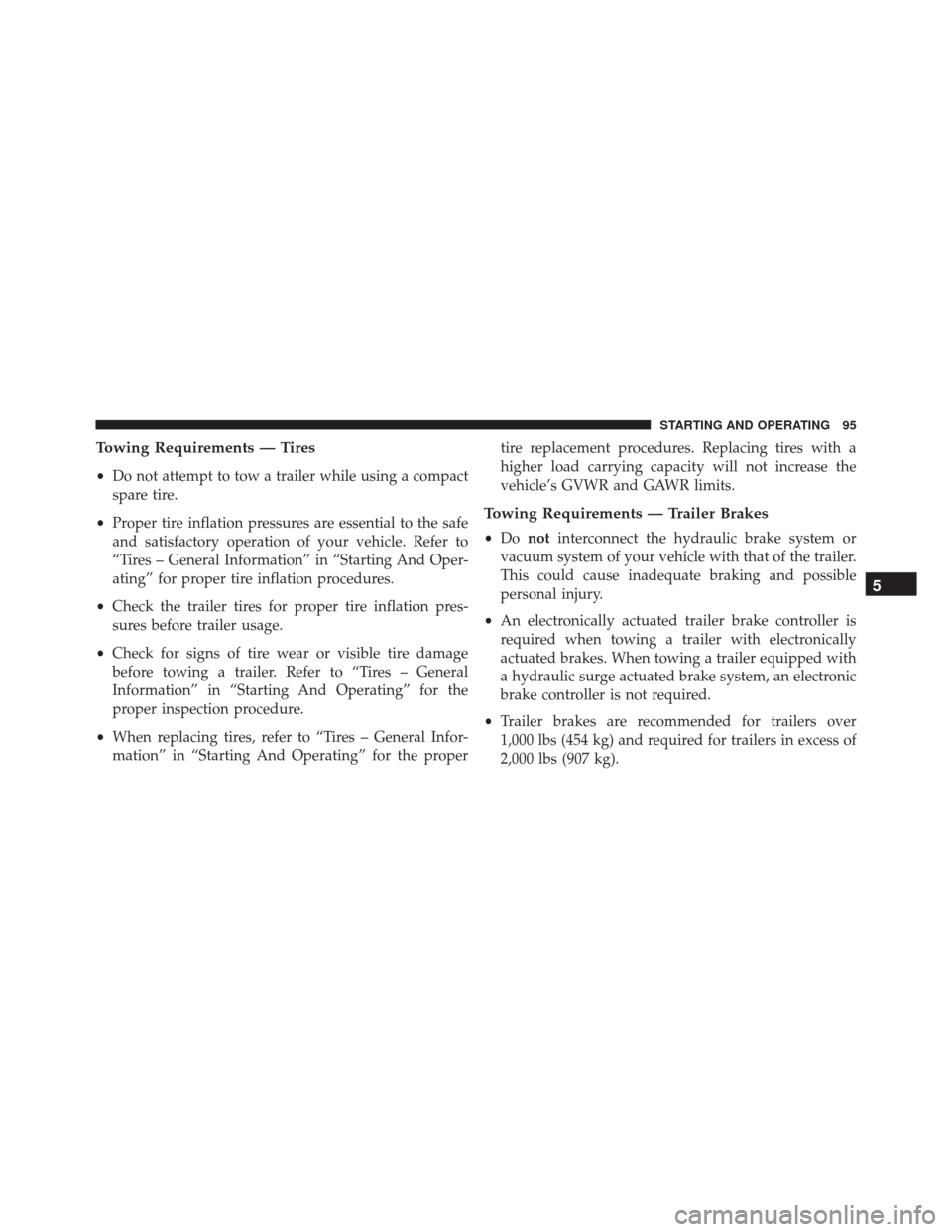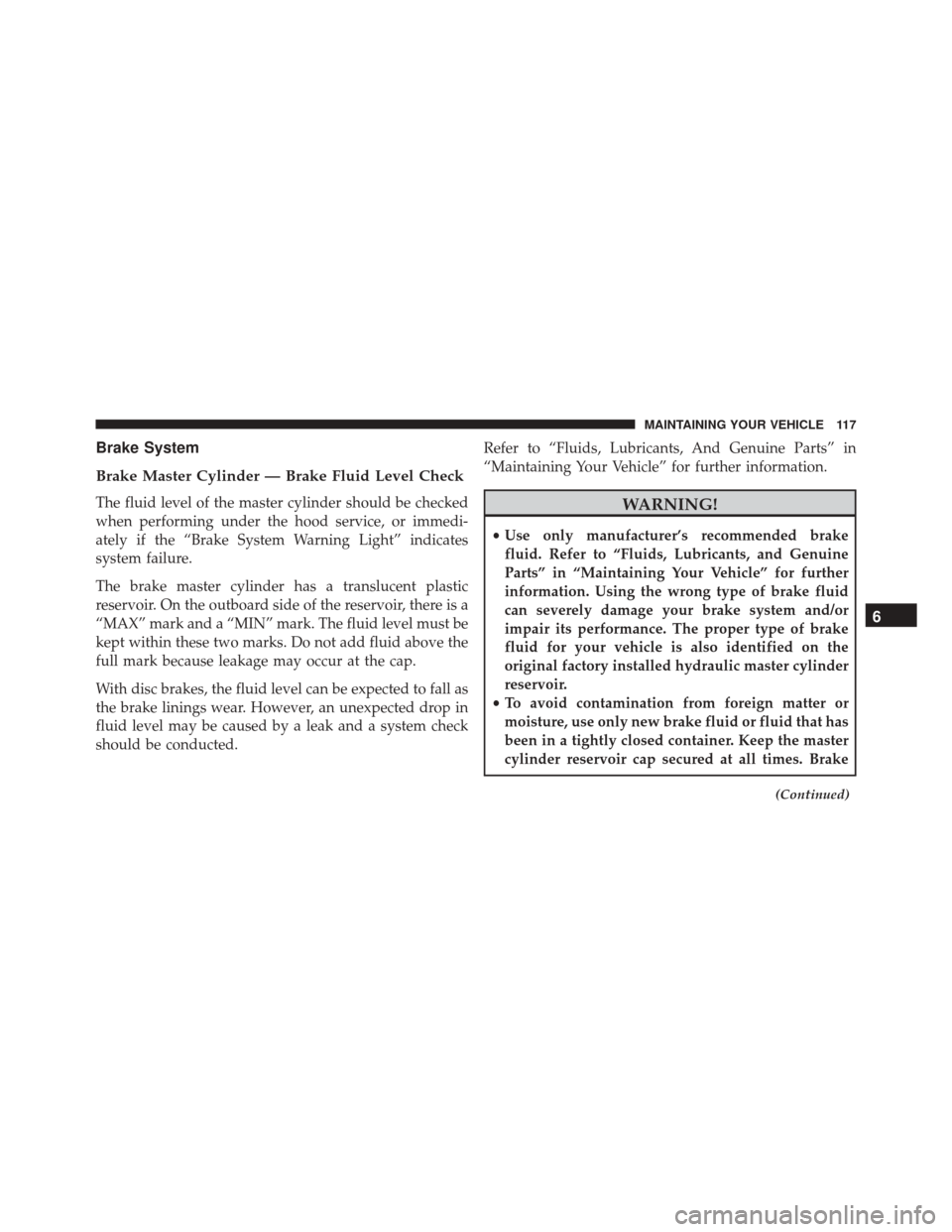Page 97 of 145

Towing Requirements — Tires
•Do not attempt to tow a trailer while using a compact
spare tire.
• Proper tire inflation pressures are essential to the safe
and satisfactory operation of your vehicle. Refer to
“Tires – General Information” in “Starting And Oper-
ating” for proper tire inflation procedures.
• Check the trailer tires for proper tire inflation pres-
sures before trailer usage.
• Check for signs of tire wear or visible tire damage
before towing a trailer. Refer to “Tires – General
Information” in “Starting And Operating” for the
proper inspection procedure.
• When replacing tires, refer to “Tires – General Infor-
mation” in “Starting And Operating” for the proper tire replacement procedures. Replacing tires with a
higher load carrying capacity will not increase the
vehicle’s GVWR and GAWR limits.
Towing Requirements — Trailer Brakes
•
Do not interconnect the hydraulic brake system or
vacuum system of your vehicle with that of the trailer.
This could cause inadequate braking and possible
personal injury.
• An electronically actuated trailer brake controller is
required when towing a trailer with electronically
actuated brakes. When towing a trailer equipped with
a hydraulic surge actuated brake system, an electronic
brake controller is not required.
• Trailer brakes are recommended for trailers over
1,000 lbs (454 kg) and required for trailers in excess of
2,000 lbs (907 kg).
5
STARTING AND OPERATING 95
Page 98 of 145

WARNING!
•Do not connect trailer brakes to your vehicle’s
hydraulic brake lines. It can overload your brake
system and cause it to fail. You might not have
brakes when you need them and could have a
collision.
• Towing any trailer will increase your stopping
distance. When towing you should allow for addi-
tional space between your vehicle and the vehicle
in front of you. Failure to do so could result in a
collision.
CAUTION!
If the trailer weighs more than 1,000 lbs (454 kg)
loaded, it should have its own brakes and they
should be of adequate capacity. Failure to do this
could lead to accelerated brake lining wear, higher
brake pedal effort, and longer stopping distances.
Towing Requirements — Trailer Lights And Wiring
Whenever you pull a trailer, regardless of the trailer size,
stoplights and turn signals on the trailer are required for
motoring safety.
The Trailer Tow Package may include a four- and seven-
pin wiring harness. Use a factory approved trailer har-
ness and connector.
96 STARTING AND OPERATING
Page 100 of 145
Towing Tips
Before setting out on a trip, practice turning, stopping,
and backing up the trailer in an area located away from
heavy traffic.
Automated Manual Transmission
DRIVE (D) (automatic mode) can be used when towing.
If frequent shifting occur while in DRIVE, select TOW/
HAUL mode, or change to MANUAL (M) mode and
manually select a lower gear.
NOTE:Using a lower gear while operating the vehicle
under heavy loading conditions will improve perfor-
mance and extend transmission life by reducing exces-
sive shifting and heat build up. This action will also
provide better engine braking.
Seven-Pin Connector
1 — Battery 5 — Ground
2 — Backup Lamps 6 — Left Stop/Turn
3 — Right Stop/Turn 7 — Running Lamps
4 — Electric Brakes 98 STARTING AND OPERATING
Page 103 of 145
MAINTAINING YOUR VEHICLE
CONTENTS
�ENGINE COMPARTMENT — 3.0L DIESEL . . . .102
� MAINTENANCE PROCEDURES ...........103
▫ Engine Oil ......................... .104
▫ Engine Air Cleaner Filter ................106
▫ Draining Fuel Filter/Water Separator .......107
▫ Fuel Filter Replacement .................108
▫ Priming If The Engine Has Run Out Of Fuel . .108
▫ Intervention Regeneration Strategy —
Message Process Flow ..................110 ▫
Maintenance-Free Batteries ..............110
▫ Cooling System .......................111
▫ Brake System ........................117
▫ Automated Manual Transmission ..........118
� FLUID CAPACITIES ....................119
� FLUIDS, LUBRICANTS AND GENUINE
PARTS ............................. .120
▫ Engine ............................ .120
▫ Chassis ........................... .123
6
Page 104 of 145
ENGINE COMPARTMENT — 3.0L DIESEL
1 — Washer Solvent Reservoir4 — Engine Oil Dipstick7 — Front Power Distribution Center
(Fuses)
2 — Power Steering Reservoir 5 — Brake Fluid Reservoir8 — Jump Starting Location
3 — Engine Oil Fill 6 — Fuel Filter Housing Location9 — Coolant Reservoir
102 MAINTAINING YOUR VEHICLE
Page 119 of 145

Brake System
Brake Master Cylinder — Brake Fluid Level Check
The fluid level of the master cylinder should be checked
when performing under the hood service, or immedi-
ately if the “Brake System Warning Light” indicates
system failure.
The brake master cylinder has a translucent plastic
reservoir. On the outboard side of the reservoir, there is a
“MAX” mark and a “MIN” mark. The fluid level must be
kept within these two marks. Do not add fluid above the
full mark because leakage may occur at the cap.
With disc brakes, the fluid level can be expected to fall as
the brake linings wear. However, an unexpected drop in
fluid level may be caused by a leak and a system check
should be conducted.Refer to “Fluids, Lubricants, And Genuine Parts” in
“Maintaining Your Vehicle” for further information.WARNING!
•
Use only manufacturer’s recommended brake
fluid. Refer to “Fluids, Lubricants, and Genuine
Parts” in “Maintaining Your Vehicle” for further
information. Using the wrong type of brake fluid
can severely damage your brake system and/or
impair its performance. The proper type of brake
fluid for your vehicle is also identified on the
original factory installed hydraulic master cylinder
reservoir.
• To avoid contamination from foreign matter or
moisture, use only new brake fluid or fluid that has
been in a tightly closed container. Keep the master
cylinder reservoir cap secured at all times. Brake
(Continued)
6
MAINTAINING YOUR VEHICLE 117
Page 120 of 145

WARNING!(Continued)
fluid in a open container absorbs moisture from the
air resulting in a lower boiling point. This may
cause it to boil unexpectedly during hard or pro-
longed braking, resulting in sudden brake failure.
This could result in a accident.
• Overfilling the brake fluid reservoir can result in
spilling brake fluid on hot engine parts, causing
the brake fluid to catch fire. Brake fluid can also
damage painted and vinyl surfaces, care should be
taken to avoid its contact with these surfaces.
• Do not allow petroleum based fluid to contaminate
the brake fluid. Brake seal components could be
damaged, causing partial or complete brake failure.
This could result in an accident.
Automated Manual Transmission
Checking Fluid Levels
To check the gear oil and check/replace the hydraulic
clutch operating system fluid, contact only your autho-
rized dealer.
NOTE: Do not add or use leak detection dye in the
hydraulic clutch operating system fluid.
WARNING!
Used gear oil contains substances that are hazardous
for the environment. It is advisable to have oil
changed by your authorized dealer where used oil
will be disposed of according to the law.
118 MAINTAINING YOUR VEHICLE
Page 125 of 145
Chassis
ComponentFluid, Lubricant, or Genuine Part
Automated Manual Transmission
• Gearbox: Full synthetic 75W-85 manual transmis-
sion fluid meeting the API GL4 specification.
• Control system: MOPAR C Series DDCT SAE 75W
Hydraulic Fluid or equivalent.
• Hydraulic Clutch Operating System: MOPAR
Brake and Clutch Fluid DOT 4 Motor Vehicle or
equivalent.
Failure to use the correct fluid may affect the function or
performance of your transmission.
Brake Master Cylinder We recommend you use MOPAR DOT 4.
Power Steering Reservoir Use Pentosin CHF 11S power steering fluid meeting
FCA US Material Standard MS-11655.
6
MAINTAINING YOUR VEHICLE 123